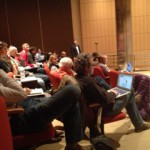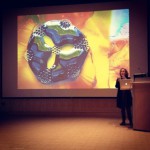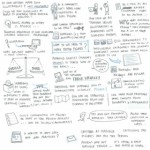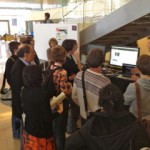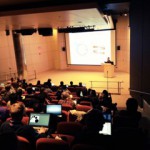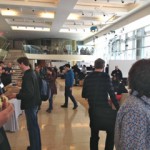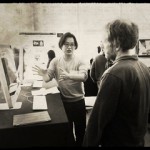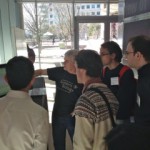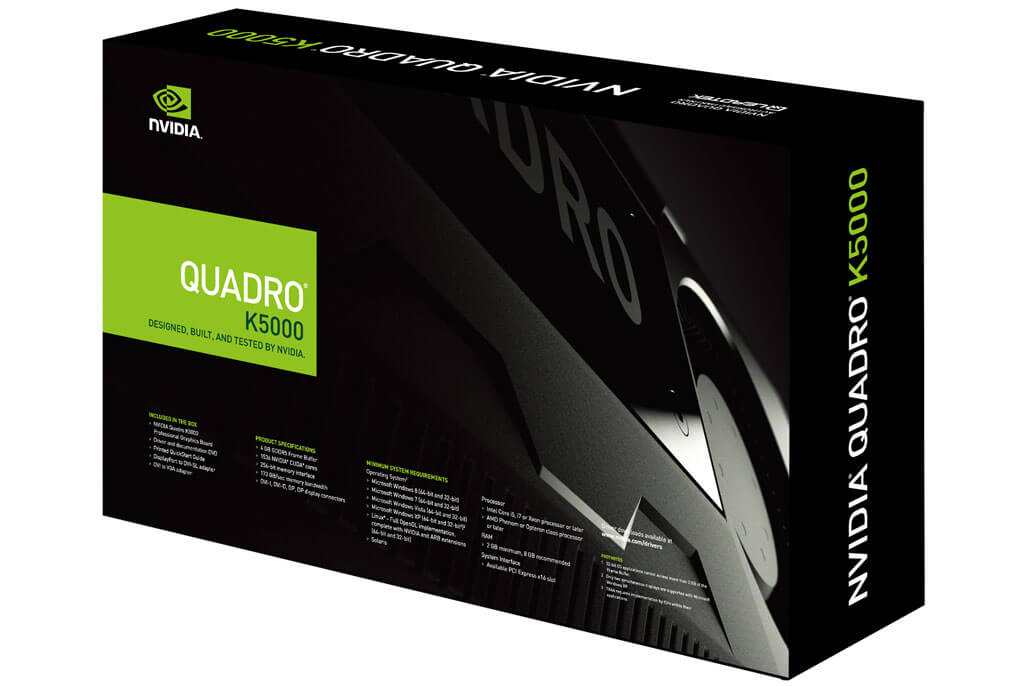A creative summary of the conference is at http://vizbi.org/2013/Photos/: as last year, Francis Rowland from the EBI made sketch-notes for each talk and put them up on flickr. Thanks Francis!
Archive for March, 2013
VIZBI 2013 sketch-notes from Francis Rowland
Sunday, March 31st, 2013Photos from VIZBI 2013
Sunday, March 24th, 2013… have begun appearing at http://vizbi.org/2013/Photos/. The images below are thumbnails only – to see larger versions, go to the 2013 photo page.
Breakout discussion notes
Thursday, March 21st, 2013Here’s the link to the Google doc from the ‘Systems Biology: beyond the hairball‘
VIZBI 2013 begins
Thursday, March 21st, 2013The 2013 posters are at http://vizbi.org/Posters/2013. For the Wednesday 6pm Breakout session, participants can propose and vote for topics at http://bit.ly/vizbi2013breakouts (you’ll need to log in with a Google ID). For Twitter please use the ‘#vizbi’ hashtag; we encourage participants to upload photos from VIZBI to Flickr and use the tag ‘vizbi’ – they will appear at http://vizbi.org/2013/Photos/.
VIZBI 2013 Keynote Speaker – Sara Irina Fabrikant
Tuesday, March 19th, 2013VIZBI 2013 first keynote speaker will be Dr. Sara Irina Fabrikant. She is currently an Associate Professor of Geography and head of the Geographic Information Visualization and Analysis (GIVA) group in the GIScience Center at the Geography Department of the University of Zurich, Switzerland. Her research and teaching interests lie in geographic information visualization and visual analytics (geovis), GIScience and cognition, graphical user interface design and evaluation, including dynamic cartography.
She was awarded a Rotary International Ambassadorial Scholarship to study Geographic Information Science for one academic year at the University of Canterbury, Christchurch, New Zealand, in 1993. She is the current elected chair of the International Cartographic Association’s Cognitive Visualization Commission. She publishes in a variety of GIScience/geovis related journals and is currently a member of the Editorial Boards of the Annals of the Association of American Geographers, Cartographica, Cartographic Perspectives, Computers Environment and Urban Systems, Journal of Spatial Information Science, Revue Internationale de Géomatique, and Transactions in GIS, in addition to her Program Committee memberships for various international GIScience/geovis related conferences (e.g., GIScience, COSIT, InfoVis (UK), etc.). She has been the Program Committee Chair of the GIScience 2010 conference. She has made various presentations at national and international professional meetings, including invited keynotes and other lectures at universities in North America, Europe, Asia, and New Zealand. Other service includes memberships of the Association of American Geographers, the International Cartographic Association’s Commission on Geovisualization, the North American Cartographic Information Society, and the Swiss Society of Cartography.
VIZBI 2013 registration closes soon
Saturday, March 16th, 2013A heads-up that conference registration and one-day registration will close Sunday, 17 March, at 11:59 pm EST. However, registration for virtual participation will remain open throughout the meeting.
VIZBI 2013 Art & Biology Keynote Address – Felice Frankel
Friday, March 15th, 2013This year’s Art & Biology keynote address will be delivered by Felice Frankel, a renowned science photographer and a researcher in the Center for Materials Science and Engineering at the Massachusetts Institute of Technology. The CSIRO-sponsored outreach keynote titled “Communicating Science Visually” will also be simulcast live to Melbourne, Australia as part of the CSIRO workshops on “Effective Visualisation for Science” and “Bioinformatics Focus on Analytical Methods”.
Working in collaboration with scientists and engineers, Felice’s images have been published in over 200 journal articles and/or covers and various other publications for general audiences such as National Geographic, Nature, Science, Angewandte Chemie, Advanced Materials, Materials Today, PNAS, Newsweek, Scientific American, Discover Magazine, and New Scientist among others. Felice foundered the IMAGE AND MEANING workshops and conferences, which promote public understanding of science through visual expression. She was principal investigator of the National Science Foundation-funded program, Picturing to Learn, which studies how visual representations aid in learning. She and her work have been often profiled in the mainstream press, and she exhibits throughout the United States and in Europe. Her limited edition photographs are included in a number of corporate and private collections.
VIZBI 2013 Tutor Spotlight – Graham Johnson’s uPy Tutorial
Thursday, March 14th, 2013Graham Johnson is an outstanding medical illustrator, animator and visualisation expert with over 15 years of professional experience. He holds a masters degree in Medical and Scientific Illustration from the John Hopkins School of Medicine and a PhD in Biophysics from the Scripps Research Institute. He illustrated the textbook Cell Biology (written by Pollard and Earnshaw) and has created numerous scientific visuals ranging from journal covers to pedagogic animations and game designs. He currently works at the UCSF as a qb3@UCSF Faculty Fellow. His visuals have won numerous prizes including the best video at the 2011 NSF International Science and Engineering Visualization Challenge as well as the best poster at VIZBI 2012. He was a speaker at the VIZBI 2012 meeting where he spoke about the challenges of visualizing “mesoscale” data and the application of uPy and autoFill frameworks (the video can be viewed here). As part of this year’s tutorial series, Graham will give an introduction on uPy (ubiquitous Python API), a system that facilitates interaction with molecular graphics software with animation systems such as Maya, Cinema 4D and Blender.
Autodesk Award for Art & Biology Poster
Wednesday, March 13th, 2013Autodesk have offered a free Maya license for the best Art & Biology poster at VIZBI 2013. Normally retailing for $3,675, Maya is widely-used for creating interactive 3D applications, video games, animated film, TV series, and visual effects. This very generous prize is offered to participants from academics and industry alike, but cannot be resold.
Each participant can upload one scientific poster and one artistically-inspired ’Art & Biology’ poster. The award for best poster in each category will be decided by popular vote. Participants are asked to judge scientific posters based on how well they communicate work of significant biological insight or importance; the best scientific poster will be awarded the NVIDIA prize. By contrast, the criteria for assessing Art & Biology posters are subjective, so the Autodesk Award will likely go to a poster that is visually compelling and original – it may help to see Art & Biology posters from previous VIZBI meetings. Further details on poster submission and upload are here.
To allow extra time for submissions for this award, we have extended the deadline for upload of Art & Biology posters only until midnight PST, March 17 .
NVIDIA Best Poster Award for VIZBI 2013
Saturday, March 9th, 2013NVIDIA have just confirmed they will again sponsor a very attractive prize for the best poster at VIZBI 2013: their high-end Quadro K5000 professional video card, retailing for US$2,199. One of the world’s fastest GPUs, this card is designed for large-scale visualization of complex data; it supports up to four displays, has 1,536 CUDA Cores, 4GB of GDDR5 memory, a single-precision performance of 2.1 Teraflops, and the ability to render 1.8 billion triangles per second. Such performance allows real-time rendering of stunning photorealistic, interactive 3D scenes. We have extended the deadline for poster upload until midnight PST, March 14 . In addition to scientific posters, each participant can also upload an artistically-inspired ‘Art & Biology’ poster (see here for more details). The award for best poster will be decided by popular vote.
VIZBI 2013 Tutor Spotlight – Drew Berry
Wednesday, March 6th, 2013
Drew Berry is a cell biologist and biomedical animator at the Walter and Eliza Hall Institute (WEHI) in Melbourne, Australia. He is best known for creating scientifically accurate and visually stunning biological animations that shed light on cellular and molecular processes and enlighten both researchers and the scientifically curious. His work has earned him international recognition including an Emmy (2005) and a BAFTA (2004). In 2010 he was awarded a Macarthur Fellowship. Drew Berry’s animations have been exhibited at such prestigious venues as MoMA and the Guggenheim. More recently, he has won widespread acclaim for his work on the video clip for Björk’s track “Hollow” from her app-based Biophilia album. He was a VIZBI 2011 keynote speaker and this year he will be running a tutorial on how he uses key features of Maya software to produce stunning animations. His VIZBI 2011 keynote address can be viewed here.








